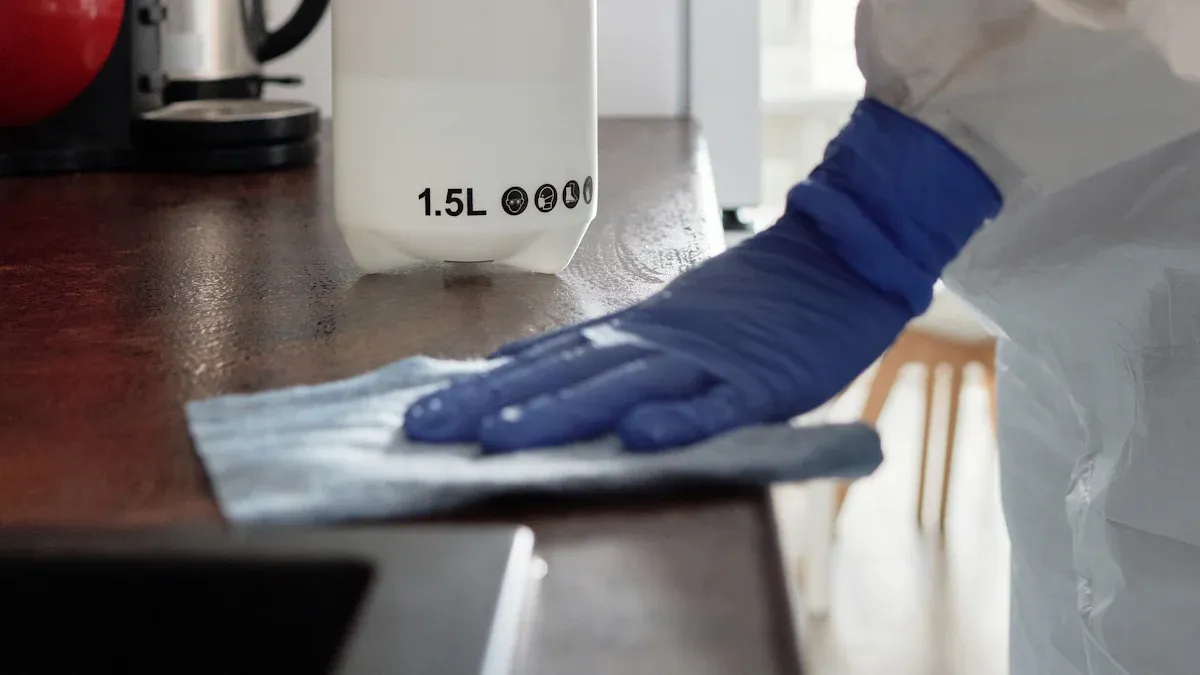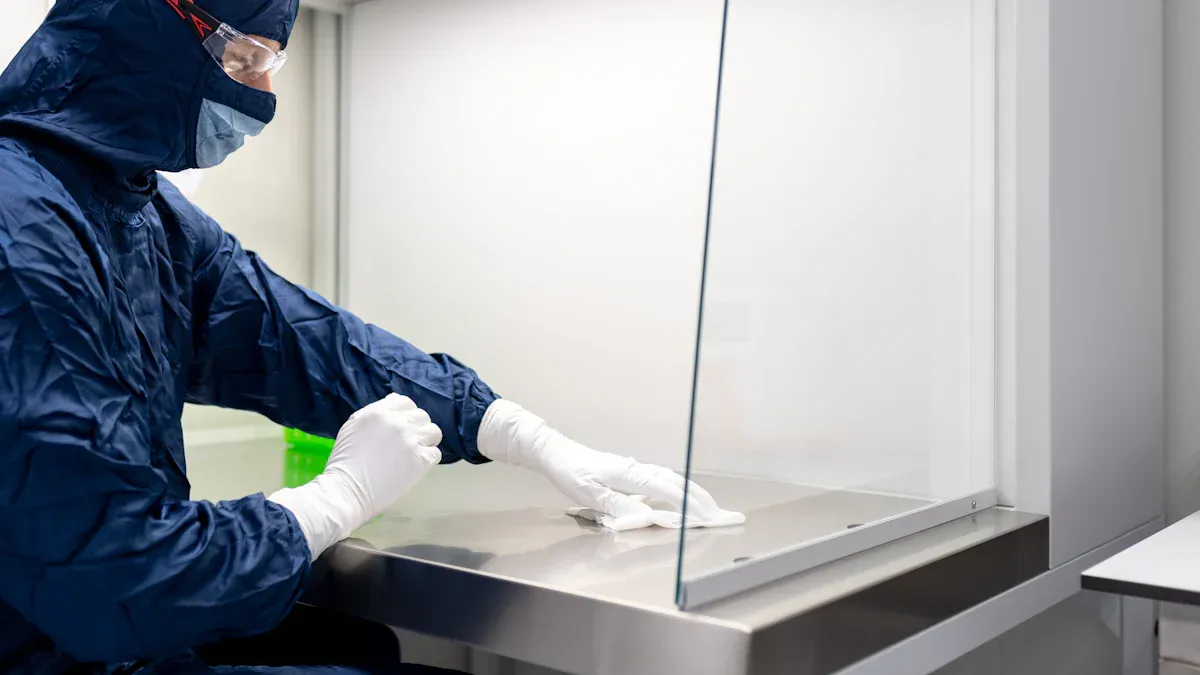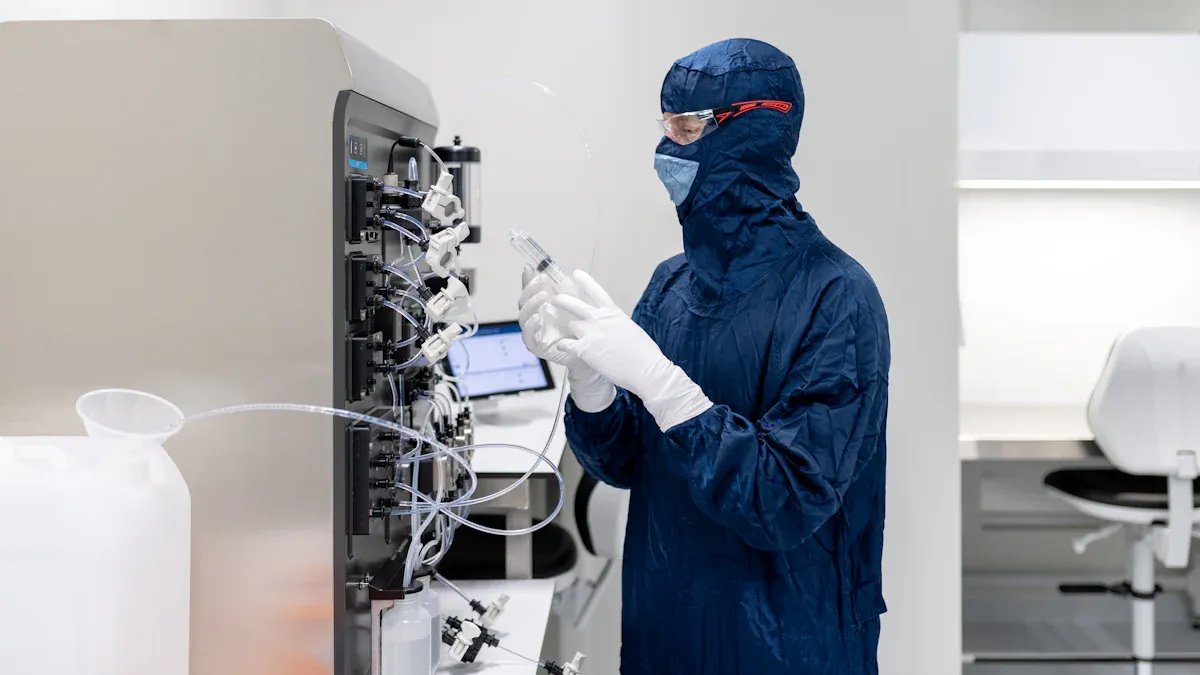

Keeping a laminar flow hood clean is very important. It helps create a germ-free workspace for your experiments. Cleaning often stops dirt in the air from ruining your work. Following cleaning rules prevents mixing of samples and keeps things safe. It also helps the equipment work well and meet safety rules. If you skip cleaning, germs can spread, tools might break, or you could fail safety checks. A clean hood also keeps air filters working, making your workspace safe and effective.
Key Takeaways
Cleaning your laminar flow hood often keeps your workspace sterile.
Different hoods need special cleaning steps. Vertical hoods clean top-down. Horizontal hoods need focus on the back wall.
Use proper supplies like lint-free wipes and 70% ethanol. This avoids damage and cleans well.
Make a cleaning plan with daily, weekly, and monthly tasks. This stops contamination and helps your equipment last longer.
UV sterilization can help kill germs after cleaning. It does not replace regular cleaning.
Types of Laminar Flow Hoods and Cleaning Implications

Knowing how to clean different laminar flow hoods keeps your workspace sterile. It also helps your equipment last longer. Vertical and horizontal hoods need different cleaning steps because of their airflow and design.
Vertical Laminar Flow Hood
A vertical hood pushes clean air from the top to the bottom. This design keeps particles away from you and your work area. But, more parts are exposed, so cleaning is simple but needs care.
Cleaning Tasks:
Wipe the work surface before and after every use to stop contamination.
Deep clean all reachable parts once a week.
Check and clean HEPA filters every month since vertical airflow collects more particles.
Advantages for Cleaning:
Tip: Always clean from the top down to follow airflow and avoid spreading dirt.
Horizontal Laminar Flow Hood
A horizontal hood moves air from the back toward you. This keeps airflow steady but can make the back wall dirty over time.
Cleaning Tasks:
Clean the work surface every day, especially if used often.
Focus on the back wall, as it gathers dirt easily.
Change HEPA filters less often but check airflow regularly.
Challenges for Cleaning:
Aspect | Vertical Laminar Flow Hoods | Horizontal Laminar Flow Hoods |
Cleaning Ease | More exposed parts, making cleaning simpler | Fewer exposed parts, harder to clean back wall |
Filter Change Frequency | Filters need changing more often due to more dirt | Filters last longer but airflow may weaken over time |
Long-term Reliability | Design reduces stress on parts, lasting longer | Simpler design but uneven airflow can cause problems |
Cleaning your laminar flow hood regularly keeps your experiments safe and accurate. By learning the needs of vertical and horizontal hoods, you can clean them better for top performance.
Step-by-Step Cleaning Process for a Laminar Flow Hood

Preparation Before Cleaning
Get the laminar flow hood ready before cleaning. Turn it on and let it run for 30 minutes. This helps steady the airflow and clears floating particles. Gather cleaning supplies like lint-free wipes, 70% ethanol, and gloves. Do not use rough materials that might scratch the hood.
Wear gloves and a lab coat to avoid adding dirt. Take out everything from the workspace so you can clean properly. If there are spills or visible dirt, clean them first before starting the regular routine.
Tip: Always clean following the airflow direction to keep areas clean.
Cleaning the Work Surface
The work surface is used the most and needs daily cleaning. Wipe it with a lint-free cloth dipped in 70% ethanol or similar disinfectant. Start at the back and move toward the front to push dirt out of the workspace.
Use absorbent paper with a water-ethanol mix for better results. Research shows this method removes dirt better than others:
Cleaning Method | Effectiveness | Notes |
Single cleaning (E70) | Poor | High amounts of contamination detected |
Sequential cleaning (W/E) | Good | More effective across all surfaces |
Nonwoven cloth (NW-E70) | Least effective | High residual contamination |
Absorbent paper (AP-W/E) | Most effective | Best results in removing contaminants |
Change cleaning cloths often to avoid spreading dirt again. For tough stains, put a little disinfectant on the spot and wipe it clean. Let the surface air dry before using it again.
Note: Never spray disinfectant on the HEPA filter. It can harm the filter.
Cleaning the Interior Walls and Ceiling
Clean the inside walls and ceiling regularly to keep them sterile. Start with the back wall, cleaning from top to bottom in overlapping strokes. Then clean the side walls the same way. Finish with the ceiling, being careful not to touch the HEPA filter or disturb airflow.
To check cleanliness, follow these steps:
Put media plates inside the hood and leave them for some time.
Incubate the plates for 1–3 days.
Count the colonies to see how clean the hood is.
This test shows if your cleaning worked and keeps the hood safe for delicate tasks.
Reminder: Clean the walls and ceiling weekly or after any contamination happens.
Post-Cleaning Validation
After cleaning your laminar flow hood, check if it’s clean and working well. This step makes sure the hood is safe for important tasks.
Key Validation Methods
Use these steps to confirm your laminar flow hood works properly:
Airflow Checks: Look at airflow lights to see if they work. Check for anything blocking the airflow. Smooth airflow keeps the workspace clean.
HEPA Filter Integrity Tests: Test the HEPA filter every month with aerosol checks. Watch for pressure changes that show the filter is wearing out. A bad filter lets dirt into the workspace.
Professional Calibration: Get experts to adjust airflow twice a year. They measure airflow speed and fix it to match the maker’s rules. This keeps the hood working longer and meeting safety standards.
Tip: Write down all checks in a log. This helps you remember maintenance and follow rules.
Testing for Contamination
Check for dirt inside the hood to see if it’s clean. Put agar plates in the workspace and leave them for a while. After a few days, look for germs growing on the plates. No germs mean your cleaning worked.
Why Validation Matters
Validation keeps your workspace safe and free from germs. It also stops the hood from breaking and protects your experiments. By doing these checks, you make sure your hood stays clean and reliable.
Best Practices for Cleaning and Maintenance
Picking the Right Cleaning Products
Using the right cleaning products keeps your laminar flow hood working well. Some cleaners can harm surfaces or leave dirt behind. Choose products that are safe and effective.
Sahara Foam Wipes soak up liquids and don’t leave particles. They clean gently without scratching and work with most disinfectants.
MiraWIPE Microfiber Wipes clean dirt well, are lint-free, and have no chemicals. They are strong and help keep the workspace sterile.
Make sure the cleaning products match the hood’s materials. Avoid strong chemicals that can damage the hood. Test new cleaners on a small spot before using them everywhere.
Tip: Always use lint-free wipes to keep the workspace clean.
Taking Care of HEPA Filters
HEPA filters are key to keeping your hood clean. They push clean air into the workspace and block dirt. Regular care keeps the air clean and safe.
The airflow removes dust, dirt, and other particles.
Clean filters stop germs from spreading in the workspace.
Well-maintained filters keep outside dirt from getting inside.
Check the HEPA filter every month for clogs or damage. If the airflow slows or the filter looks dirty, replace it. A bad filter can’t keep the workspace sterile. Write down filter checks to stay on track with maintenance.
Reminder: Don’t touch the HEPA filter. Even small damage can make it less effective.
Avoiding Cleaning Mistakes
Cleaning mistakes can harm your hood or make it less effective. Knowing what not to do helps keep the workspace clean.
Don’t Use Rough Materials: Hard brushes or cloths can scratch surfaces and trap dirt.
Don’t Spray Disinfectant on the HEPA Filter: Liquids can ruin the filter and block airflow.
Don’t Skip Daily Cleaning: Dirt builds up fast and can make the hood unsafe.
Don’t Ignore Airflow Direction: Cleaning against airflow spreads dirt instead of removing it.
Follow the maker’s cleaning rules to avoid problems. Clean gently and in order to cover all areas. Change cleaning cloths often to stop spreading dirt again.
Alert: Don’t use cleaners that leave residues. Residues can mess up experiments and reduce cleanliness.
Setting Up a Cleaning Schedule
Making a cleaning schedule for your laminar flow hood keeps it clean and working longer. A regular plan helps stop contamination, especially during delicate tasks like tissue culture. Cleaning often prevents dirt buildup, lowers germ risks, and keeps the hood running well.
Why a Cleaning Schedule is Important
A cleaning schedule keeps your workspace safe and dependable. Regular cleaning reduces contamination and helps the hood work its best. Without a schedule, dirt can pile up and ruin sterility. Cleaning regularly also meets safety rules and avoids expensive repairs.
Steps to Create a Cleaning Routine
Use these steps to make a cleaning plan that works for you:
Daily Jobs:
Clean all open surfaces inside the hood before using it. Use 70% ethanol or 80% isopropanol to remove germs. This quick step keeps the workspace ready for use.
Weekly Jobs:
Deep clean the hood’s inside and outside once a week. Focus on walls, the ceiling, and the work surface. Use lint-free wipes and safe disinfectants for the hood.
After Spills:
Clean deeply right after any spill or contamination. This stops germs from spreading and keeps the hood safe for later use.
Monthly Checks:
Look at the HEPA filter for clogs or damage. Replace it if needed to keep airflow and cleanliness.
Tips to Stick to Your Schedule
It can be hard to follow a schedule, but these tips can help:
Set Alerts: Use alarms or reminders to remember cleaning tasks.
Make a List: Write down daily, weekly, and monthly tasks. Check them off as you finish.
Keep Records: Track all cleaning activities in a log. This helps with maintenance and meeting safety rules.
Note: Don’t skip cleaning. Missing even one session can cause contamination and problems.
Benefits of Following a Cleaning Schedule
A good cleaning schedule has many benefits:
Benefit | What It Does |
Sterility | Keeps workspace clean and free of germs. |
Longer Equipment Life | Stops dirt buildup, making the hood last longer. |
Safety Compliance | Helps meet safety and legal standards. |
Better Performance | Keeps the hood working at its best. |
By following a cleaning schedule, you create a safe and effective workspace. Regular cleaning protects your hood and ensures accurate results every time.
Advanced Cleaning Methods for Laminar Flow Hoods
The Role of UV Sterilization
UV sterilization is a strong way to keep your laminar flow hood clean. It uses UV-C light to kill germs by breaking their DNA. This stops them from growing or spreading. Use this method after regular cleaning for extra safety.
Research shows that just three minutes of UV-C light can lower bacteria levels a lot. The table below shows how UV sterilization works well:
Test Location | UV-C Time Used | Bacteria Growth Result |
#1 | 3 min | Less bacteria |
#2 | 3 min | Less bacteria |
#3 | 3 min | Less bacteria |
#4 | 3 min | Less bacteria |
#5 | 3 min | Less bacteria |
#6 | 3 min | Less bacteria |
#7 | 3 min | Less bacteria |
#8 | 3 min | Less bacteria |
Tip: Turn on UV light only when the hood is empty. Always switch it off before starting work to stay safe.
Even though UV sterilization works well, it cannot replace manual cleaning. Use it as an extra step to make sure your workspace stays germ-free.
When to Consider Professional Cleaning Services
Professional cleaners can help keep your laminar flow hood in great shape. They are useful for deep cleaning and checking parts that need special care.
Experts suggest the following cleaning schedule for best results:
Cleaning Time | Tasks to Do |
Daily | Wipe surfaces and disinfect them |
Weekly/Monthly | Clean walls, back, and other areas |
Quarterly | Deep clean and check all parts |
Call professional cleaners every three months or if you notice problems. These include weak airflow or dirt buildup. Professionals use special tools to clean tricky spots and check the HEPA filter.
Reminder: Watch the HEPA filter for clogs or dirt. Replace it if it’s dirty to keep the air clean.
By mixing regular cleaning with expert help, you can make your hood last longer. This also keeps your workspace safe for important tasks.
Cleaning your laminar flow hood often keeps it safe and working well. Use the right cleaning supplies to stop germs from spreading. Take care of HEPA filters to keep the air clean. UV light can kill extra germs for better sterility. Regular maintenance helps the hood last longer and stay reliable. A clean hood protects your experiments and keeps your workspace productive.
FAQ
1. How often should you clean a laminar flow hood?
Clean the hood every day before and after using it. Do a deep cleaning once a week and check the HEPA filter monthly. Clean right away after spills to keep it sterile and safe.
Tip: Follow a cleaning schedule to keep your workspace clean and safe.
2. Can you use any cleaning agent for a laminar flow hood?
No, only use cleaning agents that are safe for the hood’s materials. Popular options include 70% ethanol or 80% isopropanol. Avoid strong chemicals that might harm surfaces or leave residues.
Reminder: Always test new cleaners on a small spot first.
3. What should you avoid when cleaning the HEPA filter?
Do not touch or spray disinfectant directly on the HEPA filter. These actions can harm the filter and make it less effective. Check it often and replace it when needed.
Alert: A damaged HEPA filter can make your workspace unsafe.
4. Is UV sterilization enough to clean a laminar flow hood?
No, UV sterilization is extra help, not a replacement for cleaning. It kills germs but doesn’t remove dirt or stains. Always clean the hood by hand before using UV light.
Note: Use UV light only when the hood is empty to stay safe.
5. How do you test if your laminar flow hood is clean?
Put agar plates inside the hood and leave them for a while. Incubate the plates for 1–3 days and check for any germs. If no germs grow, your cleaning worked well.
Tip: Regular testing helps keep your hood free from contamination.












